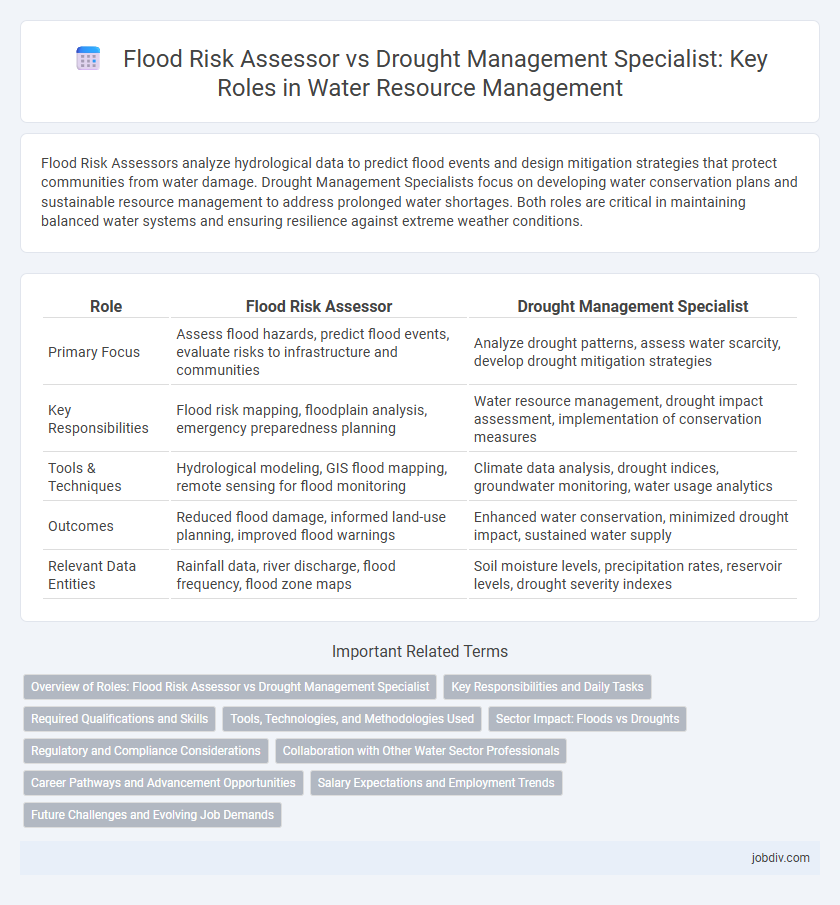Flood Risk Assessors analyze hydrological data to predict flood events and design mitigation strategies that protect communities from water damage. Drought Management Specialists focus on developing water conservation plans and sustainable resource management to address prolonged water shortages. Both roles are critical in maintaining balanced water systems and ensuring resilience against extreme weather conditions.
Table of Comparison
| Role | Flood Risk Assessor | Drought Management Specialist |
|---|---|---|
| Primary Focus | Assess flood hazards, predict flood events, evaluate risks to infrastructure and communities | Analyze drought patterns, assess water scarcity, develop drought mitigation strategies |
| Key Responsibilities | Flood risk mapping, floodplain analysis, emergency preparedness planning | Water resource management, drought impact assessment, implementation of conservation measures |
| Tools & Techniques | Hydrological modeling, GIS flood mapping, remote sensing for flood monitoring | Climate data analysis, drought indices, groundwater monitoring, water usage analytics |
| Outcomes | Reduced flood damage, informed land-use planning, improved flood warnings | Enhanced water conservation, minimized drought impact, sustained water supply |
| Relevant Data Entities | Rainfall data, river discharge, flood frequency, flood zone maps | Soil moisture levels, precipitation rates, reservoir levels, drought severity indexes |
Overview of Roles: Flood Risk Assessor vs Drought Management Specialist
Flood Risk Assessors analyze hydrological data and topographical maps to identify areas vulnerable to flooding, developing mitigation strategies to protect infrastructure and communities. Drought Management Specialists monitor precipitation patterns and soil moisture levels, designing water conservation plans and emergency response protocols to manage prolonged dry periods. Both roles require expertise in climate data and risk modeling but focus on opposing water extremes to ensure environmental resilience.
Key Responsibilities and Daily Tasks
Flood Risk Assessors analyze hydrological data, develop flood risk models, and evaluate potential impacts on communities to create mitigation strategies. Drought Management Specialists monitor water supply levels, assess drought impacts on agriculture and ecosystems, and implement water conservation plans to maintain sustainable resources. Both roles require extensive data analysis, stakeholder collaboration, and the development of adaptive response strategies tailored to their specific water-related challenges.
Required Qualifications and Skills
Flood Risk Assessors require expertise in hydrology, GIS mapping, and statistical risk analysis to evaluate flood probabilities and design mitigation strategies effectively. Drought Management Specialists need proficiency in climatology, water resource management, and predictive modeling to develop sustainable drought response plans. Both roles demand strong analytical skills, knowledge of environmental regulations, and experience with data-driven decision-making tools in water management.
Tools, Technologies, and Methodologies Used
Flood Risk Assessors employ Geographic Information Systems (GIS), remote sensing, and hydrological modeling software like HEC-RAS to analyze floodplain data and predict flood events. Drought Management Specialists utilize soil moisture sensors, climate forecasting models, and drought indices such as the Palmer Drought Severity Index (PDSI) to monitor and manage water scarcity. Both professionals integrate satellite imagery and data analytics for accurate environmental assessment but focus on different hydrological extremes with specialized tools tailored to flood or drought conditions.
Sector Impact: Floods vs Droughts
Flood Risk Assessors analyze hydrological data and infrastructure vulnerabilities to predict and mitigate the impact of excessive water events on urban and agricultural sectors. Drought Management Specialists focus on water resource allocation and soil moisture conservation techniques to minimize damage in regions experiencing prolonged water scarcity. Both roles are critical in developing adaptive strategies that safeguard ecosystems, economies, and communities facing extreme hydrological conditions.
Regulatory and Compliance Considerations
Flood Risk Assessors focus on ensuring compliance with local and national floodplain management regulations, including FEMA guidelines and environmental protection standards. Drought Management Specialists prioritize adherence to water use restrictions, state drought contingency plans, and agricultural irrigation policies to mitigate water scarcity impacts. Both roles require thorough knowledge of regulatory frameworks to develop effective strategies aligned with legal and environmental requirements.
Collaboration with Other Water Sector Professionals
Flood Risk Assessors collaborate closely with hydrologists, urban planners, and emergency management teams to design effective flood prevention strategies and ensure resilient infrastructure. Drought Management Specialists work alongside climatologists, agricultural experts, and water resource managers to develop sustainable water-saving policies and optimize drought response plans. Both roles require integrated efforts with environmental scientists and policymakers to enhance water security and mitigate extreme water-related hazards.
Career Pathways and Advancement Opportunities
Flood Risk Assessors analyze hydrological data and develop strategies to mitigate flood impacts, advancing careers through expertise in GIS technology and environmental policy. Drought Management Specialists focus on water scarcity solutions, leveraging skills in climate modeling and resource allocation to progress into leadership roles in water conservation agencies. Both career paths demand continuous learning in environmental science and offer growth opportunities in government, consultancy, and research sectors.
Salary Expectations and Employment Trends
Flood Risk Assessors typically earn median salaries ranging from $55,000 to $85,000 annually, reflecting demand in urban planning and environmental protection sectors. Drought Management Specialists often command salaries between $60,000 and $90,000, driven by increasing water scarcity concerns and agricultural impact mitigation. Employment trends indicate steady growth for both roles, with a projected 8% increase for Flood Risk Assessors and 10% for Drought Management Specialists over the next decade due to climate change challenges.
Future Challenges and Evolving Job Demands
Flood Risk Assessors face increasing challenges from climate change-induced extreme weather events, requiring advanced predictive modeling and real-time data analysis to mitigate urban and rural flood impacts. Drought Management Specialists must address prolonged water scarcity by developing sustainable water conservation strategies and enhancing irrigation efficiency amid shifting precipitation patterns. Both roles demand integration of AI and remote sensing technologies to improve resilience against unpredictable hydrological cycles and support adaptive water resource management.
Flood Risk Assessor vs Drought Management Specialist Infographic

 jobdiv.com
jobdiv.com